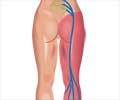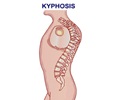A study of more than 1,500 persons who were followed over seven years has revealed that patient selection is key for vertebroplasty.
A study of more than 1,500 persons who were followed over seven years has revealed that patient selection is key for vertebroplasty. The latter is a minimally invasive treatment performed by interventional radiologists in individuals with painful osteoporotic vertebral compression fractures that fail to respond to conventional medical therapy.
Additionally, collaboration between an interventional radiologist and other medical experts in treating a patient is imperative, say researchers at the Society of Interventional Radiology's 35th Annual Scientific Meeting in Tampa, Fla."Vertebroplasty puts lives and vertebrae back together," said Giovanni C. Anselmetti, M.D., interventional radiologist at the Institute for Cancer Research and Treatment in Turin, Italy. Before treatment, many osteoporotic patients are in constant pain and cannot manage everyday activities. Vertebroplasty, a minimally invasive treatment performed by interventional radiologists under imaging guidance, stabilizes collapsed vertebrae with the injection of medical-grade bone cement into the spine. The treatment provides pain relief and improves one's quality of life—if given to appropriately selected candidates in whom conventional medical treatment has failed (such as analgesics or narcotic drugs that provide minimal or no pain release or doses that are intolerable), he further explained. "Our long-term follow-up confirmed this: pain relief and quality of life significantly improved with vertebroplasty," said Anselmetti.
Osteoporosis, the most common type of bone disease, is characterized by low bone mass and structural deterioration of the bone, resulting in an increased susceptibility to fractures. Osteoporosis affects 10 million Americans and is responsible for 700,000 vertebral fractures each year. Multiple vertebral fractures can result in chronic pain and disability, loss of independence, stooped posture and compression of the lungs and stomach.
"Vertebroplasty dramatically improves back pain within hours of the procedure, provides long-term pain relief and has a low complication rate, as demonstrated in multiple studies," said Anselmetti. Vertebroplasty provides pain relief from the complications of osteoporosis (vertebral fractures) but not the disease that caused it (osteoporosis), said Anselmetti. "For the best results, collaboration between physicians is mandatory. All osteoporotic patients need to be followed by an interventional radiologist, who determines which patients are appropriate candidates to receive vertebroplasty treatment, and an experienced medical expert (in this study, a rheumatologist) to ensure continued treatment for osteoporosis," he said.
Anselmetti illustrated a typical case: an 80-year-old Italian woman, who was diagnosed last year with two painful osteoporotic vertebral collapses, underwent medical treatment for osteoporosis (with the drug teriparatide) and was still in pain when she was prescribed an external brace. After there was evidence of two new fractures (verified by MR imaging), she received vertebroplasty, experiencing "complete pain regression, no need for the brace and a dramatic Lazarus-like ability to perform daily activities," he noted.
Researchers studied 2,251 osteoporotic patients (1,811 women; average age, 65) suffering from back-pain for vertebral collapses (MRI confirmed) who underwent a clinical interview; their medical treatment, pain grade, quality of life and extent of vertebral fracture were reviewed. Vertebroplasty was performed in 1,542 patients (1,302 women; average age, 73) when optimal medical treatment (such as biphosphonates, teriparatide, analgesics and back brace) did not help relieve pain or improve quality of life for patients over a three-month period. After vertebroplasty, patients continued to receive medical treatment with a rheumatologist. Because interventional radiologists use high-quality, image-guiding systems (such as digital flat-panel fluoroscopy with built-in rotational image acquisition), treatment time is decreased, making for a safer procedure, added Anselmetti.
Advertisement
Anselmetti said that additional studies need to be performed, such as a large randomized trial comparing conventional medical treatment to medical treatment plus vertebroplasty. In Europe, this is difficult, as patients with chronic back pain for vertebral osteoporotic fractures prefer to be treated by vertebroplasty—and not randomized into a medical treatment-only group. "Patients who are in so much pain ask if they can be considered for vertebroplasty treatment," said the co-author of "Percutaneous Vertebroplasty (PV) in the Osteoporotic Patients: Optimal Indications and Patient Selection to Improve Clinical Outcome: Personal Experience in 1,542 Patients Over Seven Years' Experience."
Advertisement
Source-Eurekalert
RAS














